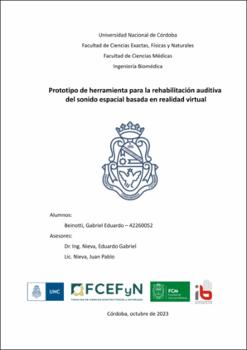| dc.contributor.advisor | Nieva, Eduardo Gabriel | |
| dc.contributor.advisor | Nieva, Juan Pablo | |
| dc.contributor.author | Beinotti, Gabriel Eduardo | |
| dc.date.accessioned | 2024-02-20T17:17:32Z | |
| dc.date.available | 2024-02-20T17:17:32Z | |
| dc.date.issued | 2023 | |
| dc.identifier.uri | http://hdl.handle.net/11086/550553 | |
| dc.description | Proyecto Integrador (I.Biom.)--FCEFN-UNC, 2023 | es |
| dc.description.abstract | El entrenamiento de la percepción espacial del sonido es un proceso complejo que requiere recursos tecnológicos específicos para atender las necesidades individuales de cada terapia de rehabilitación. Se desarrolló una herramienta en realidad virtual, utilizando el motor de desarrollo Unity y el concepto de gamificación, para favorecer este entrenamiento. Las pruebas se realizaron con gafas de Realidad Virtual "Oculus Quest 2" en un consultorio adecuado, utilizando un audiómetro Interactustic C40 y auriculares Sennheiser HDA 300. Los terapeutas siguieron las sesiones de forma remota y reportaron aceptación y eficacia en la herramienta, así como interés en su integración en su práctica habitual. Se recibieron sugerencias para mejorar el prototipo, como la inclusión de estímulos sonoros adicionales y niveles para trabajar con la localización vertical del sonido. A pesar de los resultados prometedores, se identifica la necesidad de más investigación y pruebas para maximizar la eficiencia y aplicabilidad en diferentes grupos demográficos. La herramienta está en constante evolución, con retroalimentación de profesionales del área para garantizar mejores resultados en el entrenamiento y la rehabilitación auditiva. | es |
| dc.description.abstract | Training for spatial sound perception is a complex process that requires highly trained
professionals. These professionals demand specific technological resources to address the specific
needs that arise in each rehabilitation therapy. With the objective of promoting auditory training and
rehabilitation, a tool was developed creating an application in the Unity development engine for virtual
reality environments, where 3D environments were designed to emulate auditory and visuospatial
contexts. The concept of gamification served as a cornerstone of the project.
To carry out the tests, "Oculus Quest 2" Virtual Reality goggles were used within a soundproof
office, along with an Interactustic C40 audiometer, in an open-field setting, and headphones. User
interactions and responses were monitored and controlled by therapists who followed the sessions
remotely in real-time. Therapists who used the prototype reported acceptance, expressed interest in the
tool, and highlighted its effectiveness and efficiency. They also expressed interest in integrating the tool
into their regular practice. Valuable suggestions were received for improving and adapting the
prototype, such as including additional sound stimuli and ensuring consistency between visual and
auditory movements in the environment's characters.
Despite the promising results and tool acceptance, there is a need for further extensive research
and additional testing to maximize its efficiency and applicability across different demographic groups.
The tool's evolution, along with its applications, is in a process of continuous improvement, where
feedback provided by professionals in the field allows for its adaptation to ensure better results. This
translates into the tool's evolution, increasing its effectiveness and integration in the field of auditory
training and rehabilitation. | es |
| dc.language.iso | spa | es |
| dc.rights | Attribution-NonCommercial-ShareAlike 4.0 International | * |
| dc.rights.uri | http://creativecommons.org/licenses/by-nc-sa/4.0/ | * |
| dc.subject | Proyecto Integrador I. Biom. | es |
| dc.subject | Ingeniería biomédica | es |
| dc.subject | Rehabilitación auditiva | es |
| dc.subject | Percepción espacial del sonido | es |
| dc.subject | Realidad virtual | es |
| dc.subject | Gamificación | es |
| dc.subject | Hearing rehabilitation | es |
| dc.subject | Spatial Sound Perception | es |
| dc.subject | Virtual Reality | es |
| dc.subject | Gamification | es |
| dc.title | Prototipo de herramienta para la rehabilitación auditiva del sonido espacial basada en realidad virtual | es |
| dc.type | bachelorThesis | es |
| dc.description.fil | Fil: Beinotti, Gabriel Eduardo . Universidad Nacional de Córdoba. Facultad de Ciencias Exactas, Físicas y Naturales; Argentina. | es |





